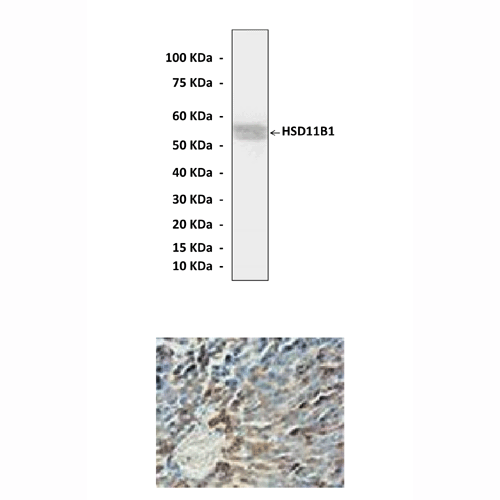Anti-HSD11B1: Polyclonal HSD11B1 Antibody |
 |
BACKGROUND Hydroxysteroid (11-beta) dehydrogenase 1 (HSD11B1) is a microsomal enzyme that catalyses the intracellular regeneration of active glucocorticoids (cortisol, corticosterone) from circulating inert 11-keto forms (cortisone, 11-dehydrocorticosterone). The biologically active glucorticoids are ligand for the receptor subfamily 3, group C, member 1 (glucocorticoid receptor) (NR3C1). The enzyme acts to amplify glucocorticoid action locally.1 This enzyme is ubiquitously expressed in human at a high level in liver and adipose tissue. The HSD11B1 expression can be regulated differently by hormones, growth factors, and cytokines. TNF-alpha increases HSD11B1 expression and activity. The activity of HSD11B1 is also stimulated by P4, prostaglandins, and cortisol. Interestingly, HSD11B1 is also highly expressed in the adult CNS in rodents and humans, notably in the hippocampus, frontal cortex and other regions key to cognitive processes. Transgenic mice lacking HSD11B1 are protected from the deficits in cognitive function with ageing that are seen in many control animals. Moreover, treatment with HSD11B1 inhibitors in humans appears to improve cognitive function in healthy elderly men and patients with type 2 diabetes.2 Thus, HSD11B1 inhibition is a target for cognitive protection against ageing. In addition, the reductase activity of HSD11B1 plays an important role in the growth and differentiation of adipose tissue via the activation of glucocorticoids. Increased HSD11B1 activity has been proposed as a mechanism underlying the association between multiple cardiovascular risk factors, whereas inhibition of HSD11B1 has been proposed for the treatment of diabetes and central obesity. Furthermore, it was also shown that that HSD11B1-regenerated cortisol acts via NR3C1 to regulate ovine endometrial functions during early pregnancy.3 The polymorphism in the HSD11B1 gene was reported to associate with an increased risk of several diseases including Alzheimer’s disease, Left ventricular mass (LVM) and may be useful genetic markers for bone metabolism.4
REFERENCES
1. Paterson, J.M. et al: Am. J. Physiol. Regul. Integr. Comp. Physiol. 289: R642-R652, 2005
2. Deary, I.J. et al: Neurosci. Lett. 393:74-7, 2006
3. Simmons, R.M. et al: Biol Reprod. 82:35-43, 2010
3. Hwang, J.Y. et al: Bone 45:1098-103, 2009
2. Deary, I.J. et al: Neurosci. Lett. 393:74-7, 2006
3. Simmons, R.M. et al: Biol Reprod. 82:35-43, 2010
3. Hwang, J.Y. et al: Bone 45:1098-103, 2009
Products are for research use only. They are not intended for human, animal, or diagnostic applications.
Параметры
Cat.No.: | CA1794 |
Antigen: | C-terminal sequence of human HSD11B1 |
Isotype: | Affinity-Purified Rabbit Polyclonal IgG |
Species & predicted species cross- reactivity ( ): | Human, Rabbit, Rat, Mouse |
Applications & Suggested starting dilutions: | WB 1:500 to 1:1000 IP n/d IHC (Paraffin) 1:50 to 1:200 ICC n/d FACS n/d |
Predicted Molecular Weight of protein: | 54/56 kDa |
Specificity/Sensitivity: | Reacts specifically with HSD11B1 of human, rabbit, mouse, and rat origin in immunostaining and western blotting, no cross-reactivity with other members of the family. |
Storage: | Store at 4° C for frequent use; at -20° C for at least one year. |
*Optimal working dilutions must be determined by end user.
Документы
Информация представлена исключительно в ознакомительных целях и ни при каких условиях не является публичной офертой








